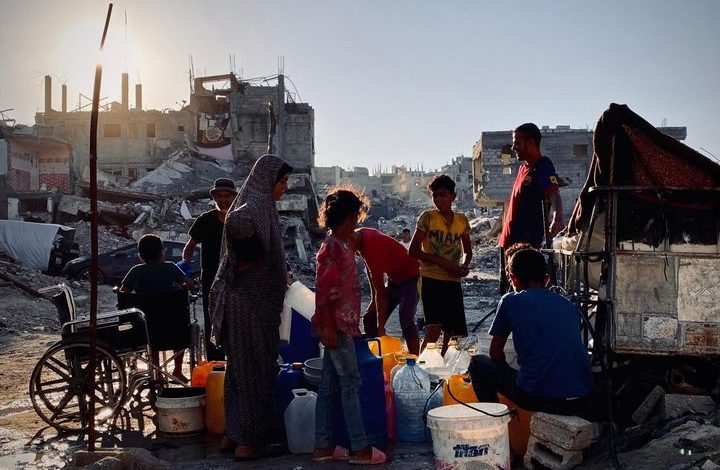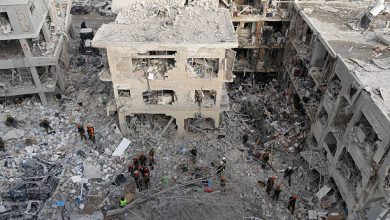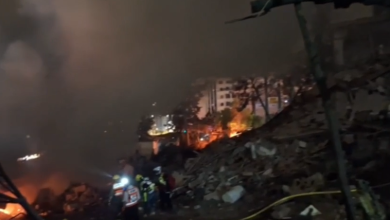Severe Water Scarcity Plagues Gaza Strip Amid Ongoing Crisis
In displacement camps, Palestinian civilians endure long waits under the intense sun to access limited and barely usable water supplies, tainted by the ongoing conflict with Israel, which has now persisted for the 20th consecutive month.

In the displacement camps, Palestinian civilians endure hours in prolonged lines under a relentless sun to obtain limited quantities of water, which is scarcely suitable for human consumption due to contamination. This situation arises from Israel’s ongoing military conflict, now in its 20th month.
Throughout the ongoing conflict, the Israeli military has significantly damaged Gaza’s water infrastructure, targeting pipelines, wells, and desalination facilities. This has rendered access to clean and safe drinking water a nearly insurmountable challenge.
In a stark development in Gaza, the average daily water consumption per person has drastically decreased from approximately 84.6 liters before the onset of conflict to a mere 3 to 5 liters. This alarming reduction falls significantly short of the World Health Organization’s emergency minimum guideline, which recommends 20 liters per individual each day.
The significant decline has directly impacted personal hygiene and public health, exacerbating the spread of diseases, particularly in densely populated areas such as shelters and displacement camps. This shortage has also resulted in serious health issues stemming from inadequate water access, including dehydration and kidney-related diseases.
Dr. Ayman al-Ramlawi, who serves as the Director of the Environmental Health and Occupational Safety Division at Gaza’s Ministry of Health, has expressed grave concerns over the ongoing humanitarian crisis, stating that the current conflict has severely disrupted everyday life, impacting vital resources and services.
In communication with Anadolu Agency, he emphasized that the water and sanitation sector is experiencing severe impacts due to the conflict, highlighting its vital connection to public health. He verified that the daily water allocation for each person has significantly decreased.
On May 10, the Gaza Water Authority announced that a significant 85% of its water and sanitation infrastructure had incurred substantial damage, resulting in a reduction in water production capacity by 70 to 80 percent.
Officials reported that the devastation of infrastructure, along with power outages and the blockade of fuel and essential supplies, has resulted in an almost complete collapse of water services. “Gaza is on the brink of dehydration,” the statement announced.
The Authority has emphasized that current per capita water consumption in Gaza has plummeted to between 3 and 5 liters per day, a stark contrast to the World Health Organization’s emergency minimum requirement of 20 liters. Prior to the conflict, statistics from the Palestinian Central Bureau of Statistics indicated an average consumption of 84.6 liters per day in 2022.
The dramatic decrease in water supply has been accompanied by a significant rise in contamination levels affecting the water available to Gaza’s residents, as reported by both the Water Authority and the Gaza Health Ministry.
UNICEF reported on May 9 that approximately 65–70% of the water infrastructure in Gaza has been severely damaged, rendering water distribution via current pipelines nearly unfeasible. Consequently, relief organizations are now resorting to delivering water by truck, but are facing significant difficulties due to persistent fuel shortages.
UNICEF’s representative, Jonathan Crickx, has verified that the existing fuel shortage is significantly hindering water supply operations and leading to the closure of desalination facilities.
A relief worker cited in the statement reported, “Children are shouldering the greatest burden of this conflict. Daily, we witness harrowing scenes of youngsters succumbing to hunger and thirst, trekking for miles in pursuit of sustenance or a sip of water.”
The report highlighted that a staggering 90% of families face challenges in securing sufficient drinking water, with a significant number unable to provide even basic bathing needs for newborns.
Dr. al-Ramlawi reported a significant increase in water contamination levels, rising from 4% prior to the conflict to 25% at present. This escalation is attributed to the extensive damage inflicted on water and sewage infrastructure, including wells and desalination facilities, compounded by a shortage of disinfectants. Consequently, 90% of households in Gaza, particularly those displaced, are now grappling with water insecurity.
He noted that the limited availability of water is inadequate for maintaining personal hygiene, which is exacerbating the spread of diseases such as diarrhea, dysentery, polio, hepatitis A, and kidney-related ailments. These health issues arise from consuming contaminated water or crops irrigated with untreated wastewater.
In the Mawasi region of Khan Younis, located in southern Gaza, the spread of scabies has become extensive, primarily attributed to the accumulation of garbage, the presence of stray animals, and inadequate sanitation. These conditions create ideal environments for insects and the spread of disease. Prior warnings from the Water Authority underscored these risks, pointing to the overflow of rainwater basins and sewage infiltrating residential areas.
Wells and Treatment Facilities Cease Operations
Al-Ramlawi stated that prior to the ongoing conflict, Gaza maintained an operational network of 250 to 260 wells supplying groundwater to residents. Currently, only 118 wells are functional, with the tally decreasing further amidst ongoing airstrikes, civilian evacuations, and widespread displacement.
Officials have raised concerns that displaced populations are resorting to using cesspits for wastewater disposal, posing a contamination threat to the aquifer and potentially exacerbating public health issues. The cessation of operations at sewage treatment facilities, attributed to fuel shortages and unsafe working conditions, has led to untreated sewage being released directly into the sea, thereby elevating pollution levels and endangering marine ecosystems.
He emphasized that the situation is poised to worsen unless the blockade is removed and essential fuel and supplies are permitted entry. “People are struggling to secure sufficient water even for a day or two,” he remarked, highlighting the severe shortage.
Since March 2, Israeli officials have enforced a comprehensive blockade on Gaza, affecting its 2.4 million inhabitants by maintaining the closure of border crossings, leaving thousands of aid trucks stranded. This situation has plunged the region into severe food scarcity, resulting in numerous fatalities.
With robust support from the United States, Israel has, since October 7, 2023, launched an extensive military campaign in Gaza. This offensive has reportedly led to over 175,000 Palestinian casualties, predominantly affecting children and women, and approximately 14,000 individuals reported missing. Additionally, the conflict has resulted in the displacement of hundreds of thousands.







